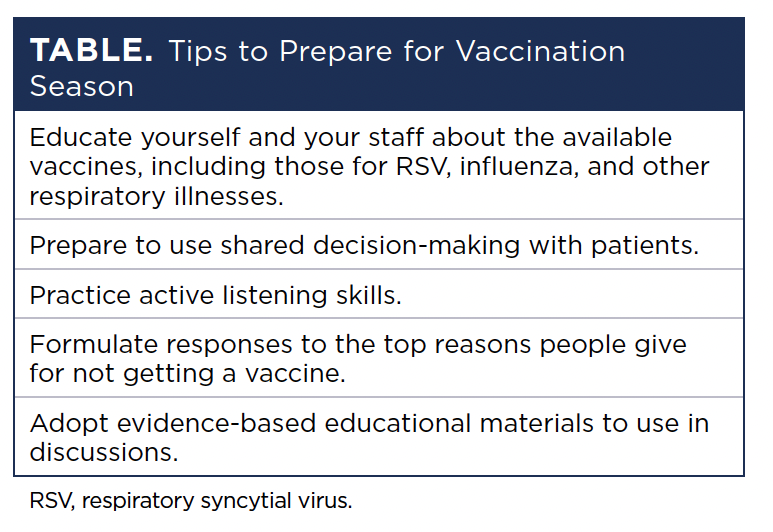About the Author
Mechelle Renee Akers, PharmD, RPh, CPh, graduated from Mercer University Southern School of Pharmacy in 1992 and practiced pharmacy for 30 years. She is now a freelance medical writer and editor.
Publication
Article
Pharmacy Times
Author(s):
Patient fears can be mitigated by pharmacists who use targeted communication strategies to bolster acceptance.
To prepare for another viral pandemic, pharmacists must be ready to tackle vaccine hesitancy. In 2019, the World Health Organization highlighted vaccine hesitancy as a global health threat that demands immediate attention.1
Exploring the effects of vaccine hesitancy on vaccination rates is essential, particularly in light of the COVID-19 pandemic and ongoing impacts on patient trust in the health care system. Notably, CDC data show that just 24.4% of adults 60 years and older were vaccinated against respiratory syncytial virus (RSV) as of May 11, 2024, although an additional 10.7% said they planned to get vaccinated.2 Additionally, as of January 31, 2024, just 17.8% of individuals who were at least 32 weeks pregnant as of September 22, 2023, were immunized against RSV.2 This highlights the substantial influence that vaccine hesitancy may exert on public health initiatives, such as the CDC’s Healthy People 2030 goal of 70% flu vaccination rates each season.3
Vaccine hesitancy is more than nonvaccination rates. It is characterized by a state of mind in which a person’s deliberate consideration leads to indecision.4 Differentiating between vaccine hesitancy and outright refusal is crucial because each requires a distinct approach. Hesitant individuals might simply need their questions addressed to decide in favor of vaccination, whereas those who firmly refuse vaccines present a more time-consuming and complex challenge to shift their stance. Tailored strategies to combat vaccine hesitancy can enable pharmacists to identify and advise individuals who may be receptive to vaccination in a more efficient and organized manner.5
WHAT IS ON THE MIND OF THE VACCINE-HESITANT INDIVIDUAL?
According to researchers, 3 key reasons for RSV vaccine hesitancy are complacency, confidence, and convenience.6 Complacency occurs when individuals believe their risk of contracting RSV is low and they do not believe vaccination is necessary for their protection. Confidence, or lack thereof, can include a lack of trust in the vaccines themselves, the health system as a whole, and policy makers who decide on the necessary vaccines. Finally, convenience is the extent to which physical availability, affordability, and health care literacy affect the uptake of vaccines.6
Mechelle Renee Akers, PharmD, RPh, CPh, graduated from Mercer University Southern School of Pharmacy in 1992 and practiced pharmacy for 30 years. She is now a freelance medical writer and editor.
Given these widespread concerns, pharmacists are well-suited to provide evidence based reassurances and address doubts about the RSV vaccine. This opens the door to making strong vaccine recommendations, a key strategy to increase vaccination rates.7
PHARMACISTS’ ROLE
Effective communication of reliable health information from credible authorities is crucial for vaccine-hesitant individuals. Investigators have developed ASPIRE, a strategic sequence of 6 actions to guide pharmacists in delivering dependable vaccine information effectively and consistently, thereby aiding in discussions with those who are hesitant about vaccines.7
The ASPIRE framework includes the following7:
Additionally, the CDC offers a framework known as SHARE, crafted to help navigate the 5 key points of discussion with patients. Although this framework was crafted for influenza vaccines, it can also be used for other common immunizations that patients may have concerns about. Talking points include the following8:
Moreover, it is worth mentioning that using structured conversation frameworks combined with educational tools promotes interactive dialogue and shared decision-making, both proven methods for enhancing vaccine uptake.9 As trusted sources of health information within their communities, pharmacists can transform vaccine hesitancy into acceptance by adopting a discussion framework, employing attentive listening, providing tailored educational materials, and offering strong vaccine recommendations.
SHIFTING FROM HESITATION TO VACCINATION
Making a strong vaccination recommendation to patients includes the preparation to make it happen.

The Table includes some tips for pharmacists to prepare for the upcoming vaccination season.
Despite the challenges of educating vaccine hesitant individuals, studies suggest that individuals who opt for immunizations are more inclined to receive them again in the future.10 As pharmacists engage in dialogue with vaccine-hesitant individuals, they lay the groundwork for not only addressing immediate concerns but also for fostering an environment of trust and influence that can have a lasting impact on vaccination patterns.

Stay informed on drug updates, treatment guidelines, and pharmacy practice trends—subscribe to Pharmacy Times for weekly clinical insights.